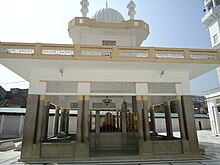Akhūnd Abdul Ghaffūr (1794–1876; also known as Saidū Bābā and the Akhūnd of Swāt) was a prominent religious saint and founder of the State of Swat. The city of Saidu Sharif, that serves as the administrative capital of Swat District, is named after him. His descendants ruled over Swat between 1876 and 1969 with the title of Wāli of Swāt.
Akhund Abdul Ghaffur Saidu Baba | |
|---|---|
 Tomb of Saidu Baba | |
| Personal life | |
| Born | 1794 |
| Died | 1876 |
| Resting place | Saidu Sharif |
| Known for | founding the state of Swat |
| Religious life | |
| Religion | Islam |
Early life
editAkhund Abdul Ghaffur was born in a Gujjar family of the upper Swat valley in 1794.[1][note 1] Saidu Baba had devoted himself to the religious study as early as the age of 18.[3]
Religious education
editFor further spiritual study, Saidu Baba came to Peshawar and became a disciple of Hafiz Azim.[3] After spending some time under guidance of Sufi saint Fazl Ahmad, he met another Sufi master Sho'ayb Tordher, who made him familiar with all four SufI orders: Naqshbandi, Qadiri, Chishti and Suhrawardi.[3] After his death in 1819, Saidu Baba isolated himself in a cowshed in Hund by the banks of the Indus River, spending time in meditation and Zikr.[4]
Religious leadership
editIn 1829, the Muslim reformist Syed Ahmad Barelvi had the malik of Hund killed in Akhund's home, as he had betrayed the Mujahideen in the battles of Haidru and Shaidu against the Sikh Empire. After this incident, Akhund left his home and wandered across Swat, living life of asceticism.[5] When Ahmad Barelvi died fighting in the battle of Balakot (1831) against the Sikhs along with hundreds of Mujahideen, many of his followers came to Buner to stay under the protection of Saidu Baba. They started a new uprising against the British Raj under Saidu Baba's leadership in 1862.[6]: 42 He returned to Saidu Sharif in Swat in September, 1835 at the age of forty-one, where he attracted a large number of devotees.[4] Afterwards, Saidu Baba became the most esteemed spiritual leader among the eastern Pashtuns.[5]
Establishment of Swat state
editIn 1835, Saidu Baba cooperated with the Afghan emir Dost Muhammad Khan and mobilized the tribes of Yaghestan against the Sikh Empire.[5][6]: 39 In return, the Afghan Emir recognized him as ruler of Swat, Lundkhwar and Mardan.[6]: 40 However, Dost Muhammad Khan's campaign proved to be a failure, and Akhund returned to Swat.[5] In 1849, he appointed Syed Akbar Shah, a direct descendant of Pir Baba, as ruler of Swat. Syed Akbar had previously served under Syed Ahmad Barelvi as secretary.[6]: 40 Saidu Baba ultimately assumed direct control of the state of Swat in the 1850s.[5]
In 1863, Saidu Baba led the Yusufzai and other groups in a battle at the Ambela Pass against the British forces, inflicting a decisive defeat upon them in Swat.[5]
Death
editWhen Saidu Baba died in 1876, the London newspapers published a brief note mentioning his death. The general public of London did not know anything about him or Swat, and this unfamiliarity prompted the poet Edward Lear to write a nonsensical poem titled "Who, or why, or which, or what, Is the Akond of Swat?", highlighting the "otherness" of the region to the English people.[5]
Literary allusions
edit- Edward Lear's "The Akond of Swat"
- George T. Lanigan (1846–1886) wrote "The Ahkoond of Swat" on hearing of Saidu Baba's death in 1878.
- Ken Nordine's rendition of the Lear piece in his 'Word Jazz' radio show.
Eponymous entities
editSee also
editNotes
edit- ^ Early sources agree on the Gujar ancestry of Akhund of Swat.[2] Some later sources attempted to establish his genealogy from the Safi tribe, as Gujars are not Pashtun.[2] For further details, see Ahmed (2012), pp. 93–94 and Inam-ur-Rahim & Viaro (2002), p. 69.
References
edit- ^ Ziad (2021), p. 227; McMahon (1981), p. 22; Beattie (2013), p. 312; Roy (1990), p. 60; Edwards (1996), p. 225; Inam-ur-Rahim & Viaro (2002), p. 69
- ^ a b Ahmed (2012), p. 93–94.
- ^ a b c Ziad (2021), p. 227.
- ^ a b Edwards (1996), p. 225.
- ^ a b c d e f g Ziad (2021), p. 228.
- ^ a b c d Haroon, Sana (2011). Frontier of Faith: Islam, in the Indo-Afghan Borderland. Hurst Publishers. ISBN 978-1849041836.
Sources
edit- Inam-ur-Rahim; Viaro, Alain M. (2002). Swat: An Afghan Society in Pakistan : Urbanisation and Change in Tribal Environment. City Press. ISBN 978-969-8380-55-7.
- Ziad, Waleed (2021). Hidden Caliphate: Sufi Saints Beyond the Oxus and Indus. Harvard University Press. ISBN 978-0-674-24881-6.
- Beattie, Dr Hugh (2013). Imperial Frontier: Tribe and State in Waziristan. Routledge. ISBN 978-1-136-83957-3.
- Roy, Olivier (1990). Islam and Resistance in Afghanistan. Cambridge University Press. p. 60. ISBN 978-0-521-39700-1.
- Edwards, David B. (1996). Heroes of the Age: Moral Fault Lines on the Afghan Frontier. University of California Press. ISBN 978-0-520-20063-0.
- McMahon, A. H. (1981). Report on the Tribes of Dir, Swat, and Bajour Together with the Utman-khel and Sam Ranizai. Saeed Book Bank.
- Ahmed, Akbar (2012). Millennium and Charisma Among Pathans (Routledge Revivals): A Critical Essay in Social Anthropology. Routledge. ISBN 978-1-136-81074-9.
Further reading
edit- Sultan-i-Rome, Dr. (2015). "ʿAbd al-Ghafūr of Swāt". Encyclopaedia of Islam, Third Edition. Brill. doi:10.1163/1573-3912_ei3_COM_24647. ISSN 1573-3912.